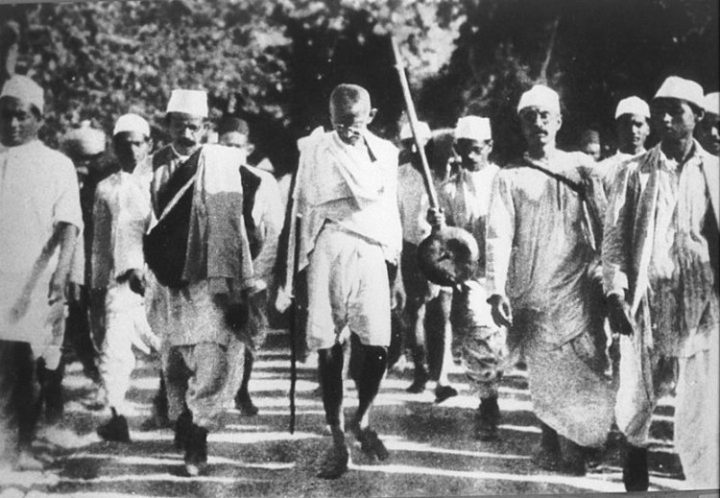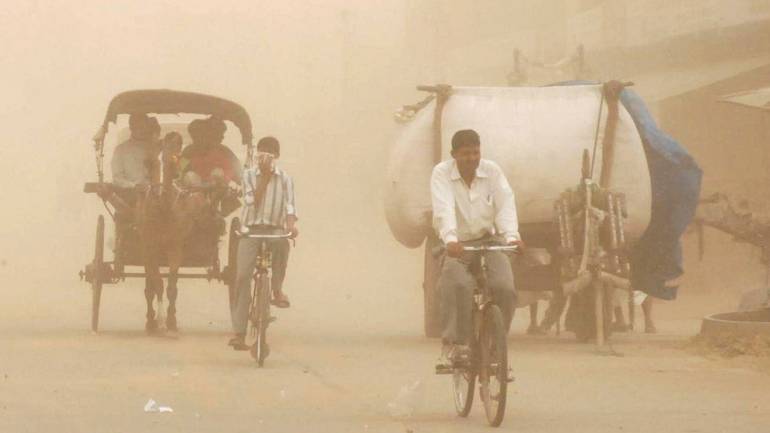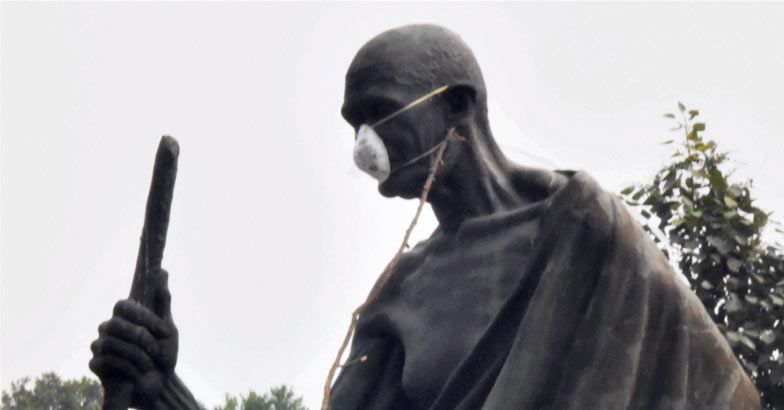The grave danger caused by air pollution worldwide has imperiled life in a manner which surpassed the danger posed by many wars and conflicts in human history. The situation is so alarming that the World Health Organisation (WHO) has convened a Global Conference on Air Pollution and Health from 29th October to 1st November 2018 to discuss the enormity of the problem and prepare strategies to deal with it. It is the first such conference ever convened in the history of humanity to deal with a situation which is marked by prevalence of high levels of toxins in air we breathe for the very survival.
It is said that India is the worst affected by air pollution in the world and the rising crises caused by such pollution is getting intensified on a day to day basis across the country. The lethal effects of air pollution combined with ever increasing and multiplying menace arising out of global warming and climate change is dangerously compromising the right to life which is the basis of all other rights and entitlements which humans enjoy and often expand to make life more meaningful and fulfilling. The sheer gravity of the situation can be gauzed from the following paragraph which finds place in the website of the WHO.
“As the world gets hotter and more crowded, our engines continue to pump out dirty emissions, and half the world has no access to clean fuels or technologies (e.g. stoves, lamps), the very air we breathe is growing dangerously polluted: nine out of ten people now breathe polluted air, which kills 7 million people every year. The health effects of air pollution are serious – one third of deaths from stroke, lung cancer and heart disease are due to air pollution. This is an equivalent effect to that of smoking tobacco, and much higher than, say, the effects of eating too much salt. Air pollution is hard to escape, no matter how rich an area you live in. It is all around us. Microscopic pollutants in the air can slip past our body’s defences, penetrating deep into our respiratory and circulatory system, damaging our lungs, heart and brain.”
The above passage is self explanatory and constitutes a grim indication of the future shape and shock that would completely overwhelm humanity if appropriate measures are not taken to keep air free from pollution and contamination. The serious breathing crises confronting humanity because of the carbon economy is not amenable to easy solution. In this context it is instructive to know that more than hundred years back Mahatma Gandhi had reflected on air pollution more and stressed on the necessity of looking at the issue of clean air from integrated perspectives- the perspective of public health, freedom and independence of India, governance, economy, spirituality and education. We require such integrated perspectives to deal with the deadly menace of air pollution and save human civilisation and planet earth.
Gandhi looked at air pollution as a public health issue in early twentieth century
Mahatma Gandhi founded Indian Opinion in 1903 in South Africa and in one of its issues of 5th March 1906 he wrote
“A man can do without food for several days and live a day altogether without waters but it is impossible to carry on without air even for a minute. If a thing that is so very vital to life is not pure, the result cannot but be deleterious.”
He wrote the above passage in the context of the large cities in England where several factories were established and laborers had to work in constricted areas and narrow spaces marked by deficiencies of clean air to breathe and deterioration of health and rise in deaths because of adverse affect of such factors on life of those who lived and worked there.
In that context he also observed: “This matter deserves consideration by Indian leaders. We suffer much because we do not realise the value of pure air, and this again is a strong reason why diseases like plague spread among us.”
If plague was a disease, attributed by Gandhi to absence of clean air in 1906, in present day world of 2018 experts explain the alarming rapid spread of lungs, heart and brain diseases to breathing of polluted air by human beings. The situation prevailing in the England of 1906 has become a common place experience across large parts of the world in twenty first century and Mahatma Gandhi’s concerns expressed about the absence of purity of air and the resultant morbidity assumes relevance for our time.

Mahatma Gandhi and Sustainable Development
The understanding of Mahatma Gandhi on pollution of air caused by factories and the attendant disease burden and the health crises it generated then in the beginning of twentieth century constituted an approach which looked at the issue from the perspective of public health. Such an approach is now being underlined to grapple with the menace of air pollution which would spare none.
The words of Mahatma Gandhi articulated on 25th July 1911 in a letter to Harilal Gandhi that open air and nutritious food constituted the remedy for tuberculosis patients affirm his approach to look at the issue of clean air as a public health issue. Again in an article authored by him under the caption “Tuberculosis” on 5th August 1911 he referred to “gospel of open air” preached by an English doctor Adam who said that the effective treatment of TB could be taken forward by breathing fresh air in open space. In the same article he wrote that it would be difficult to persuade those who breathed in the “contaminated and carbon loaded atmosphere of a stuffy room” to believe that their salvation would be ensured by “breathing pure and invigorating fresh air even as they drink pure and health giving water rather than poisoned water vomited by others”.
It is educative to note that he wrote a series of articles on “General Knowledge about Health” in 1913 when he was spearheading Satyagraha in South Africa. One such article was on Air and he wrote that “Air is the most necessary nourishment for us…” Observing that “…bad air is the cause of more than 90 per cent of diseases” and “Tuberculosis, fever and many diseases termed as infectious are all caused by the foul air we inhale”, he concluded by saying, “The first, easiest and the last means of ending them is to have fresh air, purest of the pure. There is no other Vaidya or hakim, that can match it.”
The pollution of air has been so badly compounded since Gandhi wrote about the spread of infectious disease because of it that it has caused many cardio vascular diseases and lung and brain disorders which would be difficult to treat by administering any medicine.
In Modern Civilisation air would not be available free of cost
With rare farsightedness, Mahatma Gandhi traced the cause of air pollution to many factors one of which was modern civilization which he described in his book Hind Swaraj as “a nine day wonder.” Observing in 1913 in his article “GENERAL KNOWLEDGE ABOUT HEALTH” that nature provided air free of cost for humans to breathe he noted with anguish that “…. civilization has put a price even on air. In these times, one has to go off to distant places to take the air, and this costs money…. It would not, therefore, be quite true to say in modern times that “air is free.”
How prescient was Gandhi indeed! What he wrote in 1913 has come true in twenty first century world. To get fresh air to breathe people are rushing to far off and less crowded places free from air pollution. The issue of getting rid of pollution of air by putting air purifiers at considerable cost has put a price tag on air that is worth breathing. Like ill health which is seen as an industry by some unscrupulous medical fraternity, the purification and provision of clean air is now seen as a big business opportunity involving many business houses and entrepreneurs. As a result access to pollution free air would be a business proposition with a huge cost attached to it. Therefore, Gandhi was right in saying that “civilisation has put a price on air.”

Dust Storm hits Delhi: CSE Experts Blame Climate Change
Gandhi saw the issue of air pollution and clean air from the perspective of spirituality
Gandhi had an uncanny ability to look at everything from a spiritual perspective. The manner in which he saw the issue of pure air from the perspective of spirituality is indeed noteworthy and admirable. It was evident from a message he issued on 13th November 1932 to Verrier Elwin. He wrote in that message that, “Cleanest air, cleanest water, simplest food and cleanest thinking …really means communion with God…., These are the four laws-the first three flowing from the fourth”.
In saying that access to cleanest air and cleanest water would mean communion with God Mahatma Gandhi was elevating the issue of air pollution beyond the material domain and integrating it with a life style associated with cleanness and clean thinking. Such an understanding of air pollution is also seen in the writings and commentaries of other spiritual leaders who look at the contamination of air as a spiritual issue. For example the Arch Bishop of Canterbury had described the environmental pollution of which air pollution is a major component as a spiritual issue of our time. What was done by the Arch Bishop of Canterbury in late twentieth century was done by Gandhiji in the beginning of 1930s.
Yet another example of Gandhiji looking at the air pollution from the spiritual perspective was demonstrated from the way he interpreted the human activities such as defecation on the banks of river, lakes and places of pilgrimage and the resultant contamination of air and atmosphere. He wrote an article “Does a Village mean a Dunghill” and observed with pain, ” Pilgrims defecate at the very spot where people sit, wash their faces, etc., in the Ganga and then again fill their pots at the very same spot. I have come across pilgrims defiling lakes in the same manner at places of pilgrimage. In doing this we destroy the dharma of compassion and disregard our duty to society. Such recklessness leads to pollution of air and water. Is it surprising then that cholera, typhoid and other infectious diseases follow as a result of this?” The usage of the words “Dharma of compassion” in the context of air pollution and the need to prevent the violation of such Dharma for the cause of clean air and good health brought out his sensitivity for a spiritual approach for dealing with the problem of air pollution.
Gandhi saw clean air from the perspective of Swaraj and Governance
It is fascinating to know that Gandhiji looked at Swaraj or independence of India not only from the perspectives of Hindu Muslim Unity, abolition of untouchability, economic equality, women’s empowerment, etc., but also from the perspective of clean air and clean water. While addressing a meeting in Ahmedabad in 1918 he said that at the core of swaraj remained clean, clean water and grain. Hundred years later, the core of swaraj in terms of clean air and water is getting compromised because of increasing pollution of air and water in twenty first century. So, if twenty first century India is facing air pollution of gigantic magnitude then to that extent we are deficient in terms of Swaraj.
Similarly in 1931 he reflected on just administration and wrote that in Ram Rajya or in people’s raj which he described as democracy both the rulers and the ruled would get equal access to clean air and clean water. Therefore, shall we say that mounting air pollution in India making our country the worst victim of such pollution has devalued our democracy?
Gandhi saw clean air and air pollution from educational perspective
It is educative to know that Mahatma Gandhi while reflecting and analysing the issue of air pollution right since 1906 suggested some solutions to deal with it. The most important suggestion was that he wanted to educate school and college students about the value of clean air and the steps required to keep it clean. On 16th February 1916 he while addressing the students in Madras said that students in colleges “knew nothing of fresh air or bright light, and nothing of that real vigorous independence that comes out of obedience to these laws.” In an article “Some Reflections on Education” written by him on 28th March 1932 he quoted John Ruskin who said that ” Every child, whether boy or girl, should learn the properties of pure air, clean water and clean earth, and should also learn how to keep air, water and earth pure or clean and know their benefits.”
What Mahatma Gandhi wrote in 1916 and 1932 constituted some aspects of environmental education which are of critical necessity to address not only growing air pollution but also rising levels of ecological disaster the humanity is confronting. What is required in twenty first century world is the overarching approach consisting of several perspectives woven around public health, spirituality, governance and education. The present day environmental activists are in fact suggesting for adoption of an overarching approach to deal with the menace of air pollution. They obviously do not know that Mahatma Gandhi had set such a trend long years back while he was in South Africa and during the struggle for independence. His idea of Swaraj in terms of clean air and clean water is more relevant for our time than it was when India was under foreign rule. Mahatma Gandhi as a critic of modern civilization where air is not available free of cost is of critical significance for liberating human civilization from the bondage of pollution and ecological disaster.
- Mahatma Gandhi on Air Pollution and Clean Air: Gandhian Philosophy - April 27, 2019
- India Unsafe for Women: A Critical Analysis of Thomson Reuters Report - July 3, 2018
- How Karl Marx and Communist Manifesto talk Environment Sustainability - June 8, 2018
- How PM Jawaharlal Nehru Addressed Environmental Degradation - June 6, 2018
- Mahatma Gandhi and Sustainable Development - May 31, 2018

